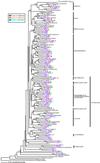Benthic eukaryotic diversity in the Guaymas Basin hydrothermal vent environment
- PMID: 12032339
- PMCID: PMC124314
- DOI: 10.1073/pnas.062186399
Benthic eukaryotic diversity in the Guaymas Basin hydrothermal vent environment
Abstract
Molecular microbial ecology studies have revealed remarkable prokaryotic diversity in extreme hydrothermal marine environments. There are no comparable reports of culture-independent surveys of eukaryotic life in warm, anoxic marine sediments. By using sequence comparisons of PCR-amplified small subunit ribosomal RNAs, we characterized eukaryotic diversity in hydrothermal vent environments of Guaymas Basin in the Gulf of California. Many sequences from these anoxic sediments and the overlaying seawater represent previously uncharacterized protists, including early branching eukaryotic lineages or extended diversity within described taxa. At least two mechanisms, with overlapping consequences, account for the eukaryotic community structure of this environment. The adaptation to anoxic environments is evidenced by specific affinity of environmental sequences to aerotolerant anaerobic species in molecular trees. This pattern is superimposed against a background of widely distributed aerophilic and aerotolerant protists, some of which may migrate into and survive in the sediment whereas others (e.g., phototrophs) are simply deposited by sedimentary processes. In contrast, bacterial populations in these sediments are primarily characteristic of anoxic, reduced, hydrocarbon-rich sedimentary habitats.
Figures


References
-
- Sogin M L, Gunderson J H, Elwood H J, Alonso R A, Peattie D A. Science. 1989;243:75–77. - PubMed
-
- Moon-van der Staay S Y, De Wachter R, Vaulot D. Nature (London) 2001;409:607–610. - PubMed
-
- Lopez-Garcia P, Rodriguez-Valera F, Pedros-Alio C, Moreira D. Nature (London) 2001;409:603–607. - PubMed
-
- Calvert S E. J Geol. 1966;76:546–565.
-
- Bazylinski D A, Farrington J W, Jannasch H W. Org Geochem. 1988;12:547–558.
Publication types
MeSH terms
Substances
Associated data
- Actions
- Actions
- Actions
- Actions
- Actions
- Actions
- Actions
- Actions
- Actions
- Actions
- Actions
- Actions
- Actions
- Actions
- Actions
- Actions
- Actions
- Actions
- Actions
- Actions
- Actions
- Actions
- Actions
- Actions
- Actions
- Actions
- Actions
- Actions
- Actions
- Actions
- Actions
- Actions
- Actions
- Actions
- Actions
- Actions
- Actions
- Actions
- Actions
- Actions
- Actions
- Actions
- Actions
- Actions
- Actions
- Actions
- Actions
- Actions
- Actions
- Actions
- Actions
- Actions
- Actions
- Actions
- Actions
- Actions
- Actions
- Actions
- Actions
- Actions
- Actions
- Actions
- Actions
- Actions
- Actions
- Actions
- Actions
- Actions
- Actions
- Actions
- Actions
- Actions
- Actions
- Actions
- Actions
- Actions
- Actions
- Actions
- Actions
- Actions
- Actions
- Actions
- Actions
- Actions
- Actions
- Actions
- Actions
- Actions
- Actions
- Actions
- Actions
- Actions
- Actions
- Actions
- Actions
- Actions
- Actions
- Actions
- Actions
- Actions
- Actions
- Actions
- Actions
- Actions
- Actions
- Actions
- Actions
- Actions
- Actions
- Actions
- Actions
- Actions
- Actions
- Actions
- Actions
- Actions
- Actions
- Actions
- Actions
- Actions
- Actions
- Actions
- Actions
- Actions
- Actions
- Actions
- Actions
- Actions
- Actions
- Actions
- Actions
- Actions
- Actions
- Actions
- Actions
- Actions
- Actions
- Actions
- Actions
- Actions
- Actions
- Actions
- Actions
- Actions
- Actions
- Actions
- Actions
- Actions
- Actions
- Actions
- Actions
- Actions
- Actions
- Actions
- Actions
- Actions
- Actions
- Actions
- Actions
- Actions
- Actions
- Actions
- Actions
- Actions
- Actions
- Actions
- Actions
- Actions
- Actions
- Actions
- Actions
- Actions
- Actions
- Actions
- Actions
- Actions
- Actions
- Actions
- Actions
- Actions
- Actions
- Actions
- Actions
- Actions
- Actions
- Actions
- Actions
- Actions
- Actions
- Actions
- Actions
- Actions
- Actions
- Actions
- Actions
- Actions
- Actions
- Actions
- Actions
- Actions
- Actions
- Actions
- Actions
- Actions
- Actions
- Actions
- Actions
- Actions
- Actions
- Actions
- Actions
- Actions
- Actions
- Actions
- Actions
- Actions
- Actions
- Actions
- Actions
- Actions
- Actions
- Actions
- Actions
- Actions
- Actions
- Actions
- Actions
- Actions
- Actions
- Actions
- Actions
- Actions
- Actions
- Actions
- Actions
- Actions
- Actions
- Actions
- Actions
- Actions
- Actions
- Actions
- Actions
- Actions
- Actions
- Actions
- Actions
- Actions
- Actions
- Actions
- Actions
- Actions
- Actions
- Actions
- Actions
- Actions
- Actions
- Actions
- Actions
- Actions
- Actions
- Actions
- Actions
- Actions
- Actions
- Actions
- Actions
- Actions
- Actions
- Actions
- Actions
- Actions
- Actions
- Actions
- Actions
LinkOut - more resources
Full Text Sources
Molecular Biology Databases

